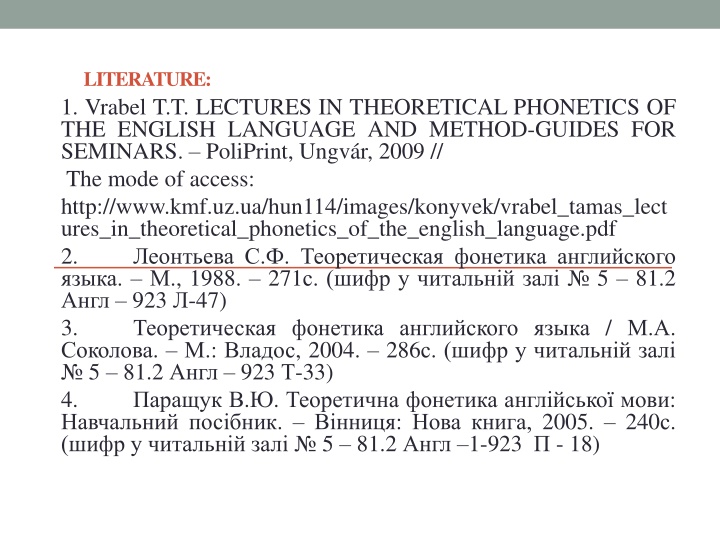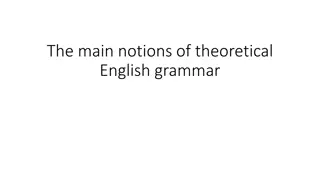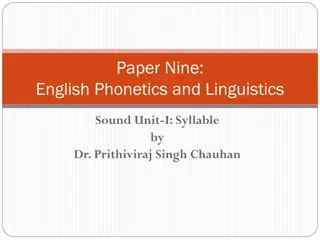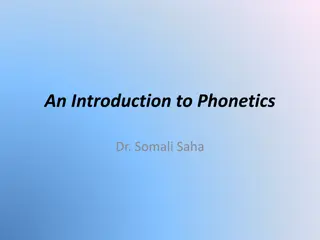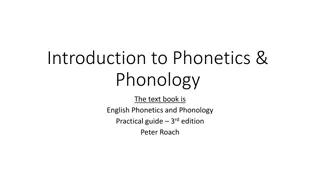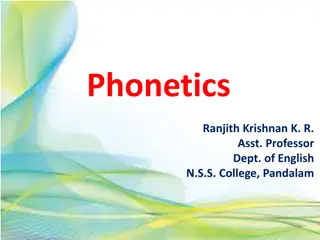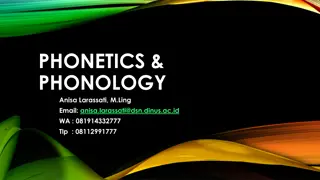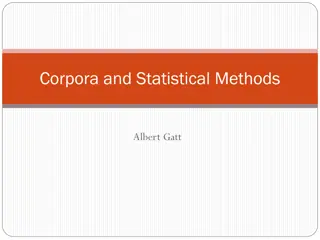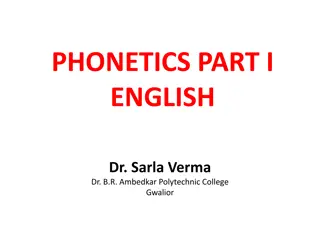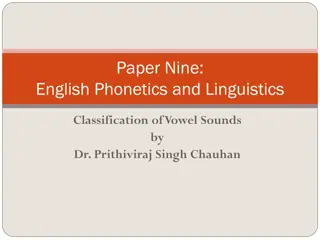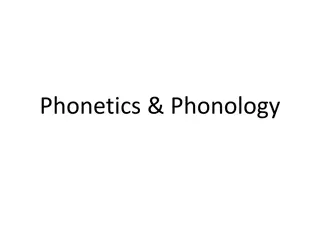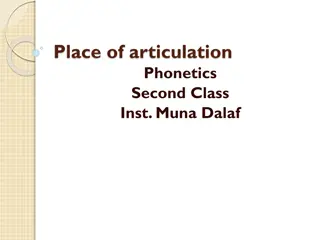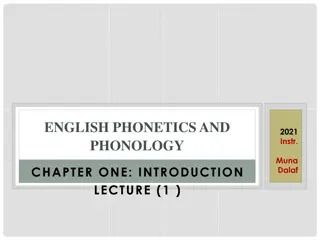Theoretical Phonetics of the English Language
Phonetics is the study of speech sounds, their production, transmission, and reception. It involves the analysis of all possible speech sounds and their role in language construction. This field explores the connection of phonetics with grammar, lexicology, and stylistics, highlighting how pronunciation, intonation, and word stress impact language usage and understanding. Through detailed examinations of phonetic investigation methods and practical applications, this literature underscores the significance of phonetics in linguistic analysis and communication.
Download Presentation

Please find below an Image/Link to download the presentation.
The content on the website is provided AS IS for your information and personal use only. It may not be sold, licensed, or shared on other websites without obtaining consent from the author.If you encounter any issues during the download, it is possible that the publisher has removed the file from their server.
You are allowed to download the files provided on this website for personal or commercial use, subject to the condition that they are used lawfully. All files are the property of their respective owners.
The content on the website is provided AS IS for your information and personal use only. It may not be sold, licensed, or shared on other websites without obtaining consent from the author.
E N D
Presentation Transcript
LITERATURE: 1. Vrabel T.T. LECTURES IN THEORETICAL PHONETICS OF THE ENGLISH LANGUAGE AND METHOD-GUIDES FOR SEMINARS. PoliPrint, Ungv r, 2009 // The mode of access: http://www.kmf.uz.ua/hun114/images/konyvek/vrabel_tamas_lect ures_in_theoretical_phonetics_of_the_english_language.pdf 2. . . . ., 1988. 271 . ( 5 81.2 923 -47) 3. / . . . .: , 2004. 286 . ( 5 81.2 923 -33) 4. . . : . : , 2005. 240 . ( 5 81.2 1-923 - 18)
Phonetics as a science. Phonic substance of language and ways of its analysis and description. 1. Phonetics as a Linguistic Discipline. Phonetics as the most fundamental branch of linguistics, its role in the development of science, famous phoneticians and their contributions to its development. 2. Divisions and Branches of Phonetics. 3. Methods of Phonetic Investigation. 4. Phonetics and Other Disciplines. 5. Spheres of Practical Application. 6. Sounds of speech as articulatory and acoustic units. 7. Phonetics and phonology. 8. Language use in oral verbal communication. 9. Pronunciation as a way of materializing of oral form of language. 10. Phonic structure of language and its components (the system of sounds,the syllabic structure, word/lexical stress, intonation). 11. Units of language vs. speech. 12. Theories of teaching pronunciation in current TEFL/TESOL practices.
1. Phonetics as a Linguistic Discipline Phonetics is the study of how speech sounds are made, transmitted, and received, i.e. phonetics is the study of all possible speech sounds. The human vocal apparatus can produce a wide range of sounds; but only a small number of them are used in a language to construct all of its words and utterances.
The connection of phonetics with grammar is exercised through orthography and intonation. Thus for example, the system of reading rules helps to pronounce singular and plural forms of nouns correctly (man men, foot feet). The use of the necessary nuclear tone helps to distinguish between different types of sentences. It s especially important in colloquial speech where one and the same sentence may be understood as a statement when pronounced with the falling tone (He came \ home.) or a question when pronounced with the rising tone (He came / home?). The connection of phonetics with lexicology is exercised through pronunciation and word-stress. For instance, some corresponding forms of verbs and nouns are homographs identical in spelling. They may be distinguished with the help of pronunciation (wind [w nd] to wind [wa nd]), word-stress( an 'object to ob'ject), or the combinative use of word-stress and pronunciation (increase [' nkr s] to increase [in'kri:z]). The connection of phonetics with stylistics is exercised through intonational components or graphical expressive means. For example, repetition of words serves as the basis of rhythm and rhyme; capitalization or italics underline special prominence of information: Look to left and look to right, Note what traffic is in sight. Note, too, which light can be seen: The Red, the Amber, or the Green. Children, keep from dangerous play And THINK before you cross today.
2. Divisions and Branches of Phonetics Phonetics is subdivided into practical and theoretical. Practical or normative phonetics studies the substance, the material form of phonetic phenomena in relation to meaning. Theoretical phonetics is mainly concerned with the functioning of phonetic units in the language. Theoretical phonetics regards phonetic phenomena synchronically without any special attention paid to the historical development of English. Phonetics is itself divided into two major components: segmental phonetics, which is concerned with individual "segments" of speech) and suprasegmental phonetics whose domain is the larger units of connected speech: syllables, words, phrases and texts. sounds (i.e.
Three traditional branches are generally recognized: 1. articulatory phonetics( ) is the study of the way speech sounds are made ('articulated') by the vocal organs, i.e. it studies the way in which the air is set in motion, the movements of the speech organs and the coordination of these movements in the production of single sounds and trains of sounds; 2. acoustic phonetics( ) studies the physical properties of speech sound, as transmitted between the speaker s mouth and the listener s ear; 3. auditory phonetics( ) studies the perceptual response to speech sounds, as mediated by ear, auditory nerve and brain, i.e. its interests lie more in the sensation of hearing, which is brain activity, than in the psychological working of the ear or the nervous activity between the ear and the brain. The means by which we discriminate sounds quality, sensations of pitch, loudness, length, are relevant here. The fourth branch 'functional phonetics' ( ) is concerned with the range and function of sounds in specific languages. It is typically referred to as phonology.
3. Methods of Phonetic Investigation. Linguists distinguish between two groups of methods, which may be applied when investigating the sound matter of the language: subjective and objective methods of phonetic analysis. Subjective (introspective) methods were available from the beginning of the study of sounds. They include the oldest and simplest methods of phonetic investigation: sensory analysis and direct observation. These consist in observing and fixing the movements and positions of one s own or other people s organs of speech in the production of various speech sounds, as well as in analyzing and comparing one s own articulatory and auditory impressions. Objective (instrumental) methods of phonetic analysis appeared in the second half of the XXth century with the development of such sciences as physiology and physics. They involve the use of various instrumental techniques like palatography, laryngoscopy,X-rayphotography, electromyography, etc. If controlled phonetic experiments employ the use of measuring devices and instrumental techniques, this sub-field of phonetics is called instrumental phonetics. This type of investigation together with sensory analysis is widely used in experimental phonetics. The "subjective" methods vs. the "objective" methods The tools for investigating the speech organs: direct observation; x-ray photography or x-ray cinematography; laryngoscopic investigation of vocal cord movement; palatography; glottography, etc.
4. Phonetics and Other Disciplines Phonetics and social sciences: Sociophonetics studies the ways in which pronunciation interacts with society. Psycholinguistics covers an extremely broad area: the acquisition of language by children, the extent to which language mediates or structures thinking; the extent to which language is influenced and itself influences such things as memory, attention, recall and constraints on perception; and the extent to which language has a certain role to play in the understanding of human development; the problems of speech.
5. SPHERES OF PRACTICAL APPLICATION. According phonetics phonetics and special phonetics. General phonetics studies all the sound- producing possibilities of the human speech apparatus and the ways they are used for the purpose of communication. Special phonetics is based on general phonetics and studies the phonetic system of a particular language. to can the be sphere divided of application into general
6.Sounds of speech as articulatory and acoustic units Human speech is the result of a highly complicated series of events that can be divided into 6 stages: psychological, physiological, physical/acoustic, reception, transmission, linguistic interpretation. They are interconnected and constitute two parts of the speech act.
Parts of the speech act I. The first part of the speech act contains the stages made by the speaker. It includes the following: 1) the psychological stage concerns the formation of the concept in the brain of a speaker; 2) when the message is formed, it is transmitted along the nervous system to the speech organs which produce particular speech sounds within the physiological stage; 3) the movements of the speech apparatus disturb the air and produce sound waves during the acoustic stage. II. The second part of the speech act includes the stages made by the listener, because any communication requires a listener as well as a speaker: 1) the sound waves are perceived by the listener s ear within the reception stage; 2) the spoken message is transmitted through the nervous system to the listener s brain transmission stage; 3) the information conveyed gets its linguistic interpretation. during the
The articulatory aspect comprises all the movements and positions of the speech organs necessary to pronounce a speech sound. Speech organs have different functions and thus can be divided into four groups: 1) The power (respiratory) mechanism supplies the energy in the form of air pressure and regulates the force of air stream. It includes the following speech organs: the diaphragm, the lungs, the bronchi, the windpipe (trachea), the glottis and the supra-glottal cavities, the larynx, the mouth cavity, the nasal cavity. 2) The vibration mechanism functions as a vibrator when producing voice. It consists of the vocal cords (voice box), situated in the larynx. 3) The resonator mechanism consists of the speech organs which function as principal resonators. These are the pharynx, the larynx, and the mouth and nasal cavities. 4) The obstruction mechanism consists of the tongue (the blade, the tip, the front, the back/dorsum), the lips, the teeth, the soft palate with the uvula, the hard palate, the alveolar ridge. These speech organs form different types of obstructions.
The acoustic aspect studies sound waves. It is the way in which the air vibrates between the speaker s mouth and the listener s ear. There may be different types of vibrations which affect the tone of the voice. The basic vibrations of the vocal cords over their whole length produce the fundamental tone of voice. The simultaneous vibrations of parts of the vocal cords produce partial tones (overtones). The number of vibrations per second is called frequency. Frequency of basic vibrations of the vocal cords is called the fundamental frequency which is very important in phonetic investigation. It determines the pitch of the voice and forms the acoustic basis of speech melody.
The auditory (sound-perception) aspect is a physiological and psychological mechanism. It combines the process of hearing with the process of discriminating sounds. The human ear transforms vibrations of the air into nervous commands and transmits them to the brain. This enables the listener discriminate the quality, pitch, loudness, and length of sounds and identify the sounds. The functional (linguistic) aspect is concerned with the linguistic function of individual sounds and segments of speech. From the functional point of view all sound phenomena of any language present a clear cut system of interdependent units: phonemes, syllables, stress, and intonation. These phonetic phenomena have no meaning of their own. Their linguistic function is to constitute and distinguish larger meaningful units, such as morphemes, words, phrases, etc.
7. Phonetics and phonology. Phonology is the study of those segmental (speech sound types) and prosodic (intonation) features which have a differential value in the language. It studies the way in which speakers systematically use a selection of units phonemes or intonemes in order to express meaning. It investigates the phonetic phenomena from the point of view of their use. The primary aim of phonology is to discover the principles that govern the way that sounds are organized in languages, to determine which phonemes are used and how they pattern the phonological structure of a language. The properties of different sound systems are then compared, and hypotheses developed about the rules underlying the use of sounds in particular groups of languages, and in all the languages - phonological universals. Phonology also solves: 1. the problem of the identification of the phonemes of a language; 2. the problem of the identification of the phoneme in a particular word, utterance. It establishes the system of phonemes and determines the frequency of occurrence in syllables, words, utterances. The distribution and grouping of phonemes and syllables in words are dealt with an area of phonology which is called phonotactics. Within phonology, two branches of study are usually recognized: SEGMENTAL and SUPRA-SEGMENTAL. Segmental phonology analyses speech into discrete segments, such as phonemes; supra-segmental or non- segmental phonology analyses those features which extend over more than one segment, such as intonation contours.
8.Language use in oral verbal communication. Verbal communication is the process of transmitting a verbal message from sender/speaker/addressor to a receiver/listener/addressee channel/medium. In verbal communication the communicators use a verbal code language and a system of non-verbal codes body language, touch, appearance, spatial behavior etc. Language as a code consists lexicon/vocabulary, a grammar and a phonology. It exists in its two material forms: oral and written. When language is used in communication, the communicators apply language skills (listening, speaking, reading and writing) to put their knowledge of language resources (phonology, grammar and vocabulary) into action to produce discourse ( ). Discourse is a continuous stretch of language (oral or written) which has been produced as the result of an act of communication. a through a resources: of the following a
9.Pronunciation as a way of materializing of oral form of language. The concept pronunciation has several meanings in present-day phonetics. In its narrow meaning it is restricted to the features manifested in the articulation of the sounds of a language. Its wide interpretation implies the entity of discourse features relating to: 1. the SOUND SYSTEM of a language (the so-called segmental phonemes in the form of their actual speech manifestations allophones or variants); 2. the SYLLABIC STRUCTURE of a language (syllable formation and syllable division); 3. WORD-STRESS/LEXICAL STRESS; 4. INTONATION as a complex unity of pitch ( ), force ( ) and temporal ( ) components. In discussing the pronunciation of English we can focus on one or both of two aspects: 1. on the one hand, we may want to describe WHAT SPEAKERS DO WHEN 'HEY ARE SPEAKING ENGLISH. This is the aspect of SPEECH ( ), an activity carried on by communicators who use English in communicating. 2. on the other hand, we may address HARACTERISTICS OF ENGLISH WORDS AND SENTENCES (DISCOURSE) that are realized in speech? This is the aspect of LANGUAGE ( ). the question, WHAT ARE THE
10.Phonic structure of language and its components (the system of sounds, the syllabic structure, word/lexical stress, intonation). The phonic system of any language comprises 4 components: phonemic, syllabic, accentual and intonational. The first is the phonemic component. It is the basic component represented by the system of segmental phonemes of a language existing in the material form of their allophones. It may have manifestations in: the system of phonemes as discrete isolated units; the distribution of allophones of different phonemes; the methods of joining speech sounds. The second component is the syllabic structure of words. It has two manifestations which are inseparable from each other: syllable formation and syllable division. The third component is the accentual structure of words when pronounced in isolation. Its main manifestations are: the acoustic nature of word stress; the stress position in disyllabic and polysyllabic words; the degrees of word stress. The fourth component is the intonational structure of utterances with the following manifestations: the prosodic components of intonation; the structure of intonation patterns; the representation of patterns in intonation groups. All the components of the phonetic system of the language constitute its pronunciation.
11.Units of language vs. speech. Speech is an activity which is carried on numerous events; languageis knowledge, a code which is known and shared by speakers who use their knowledge for transmitting and interpreting verbal messages in these events The units of language from largest to smallest are: TEXT SENTENCE PHRASE WORD MORPHEME PHONEME The units of speech from largest to smallest are: DISCOURSE UTTERANCE TONE UNIT SYLLABLE SEGMENT ARTICULATORY FEATURE DISTINCTIVE FEATURE
12.Theories of teaching pronunciation in current TEFL/TESOL practices. Pronunciation pronunciation of isolated sounds or words. When the Communicative Approach to language teaching began to take over in the mid-late -1970s, most of techniques and materials for teaching pronunciation at the segmental level were rejected on the grounds as being incompatible with teaching language as communication. Today pronunciation instruction is moving away from the segmental/supra- segmental debate and toward a more balanced view. This view recognizes that both an inability to distinguish sounds that carry a high functional load, e.g. list least, and an inability to distinguish supra-segmental features (such as intonation and stress differences) can have a negative impact on the oral communication - and the listening comprehension abilities - of normative speakers of English. in the past was largely identified with accurate
